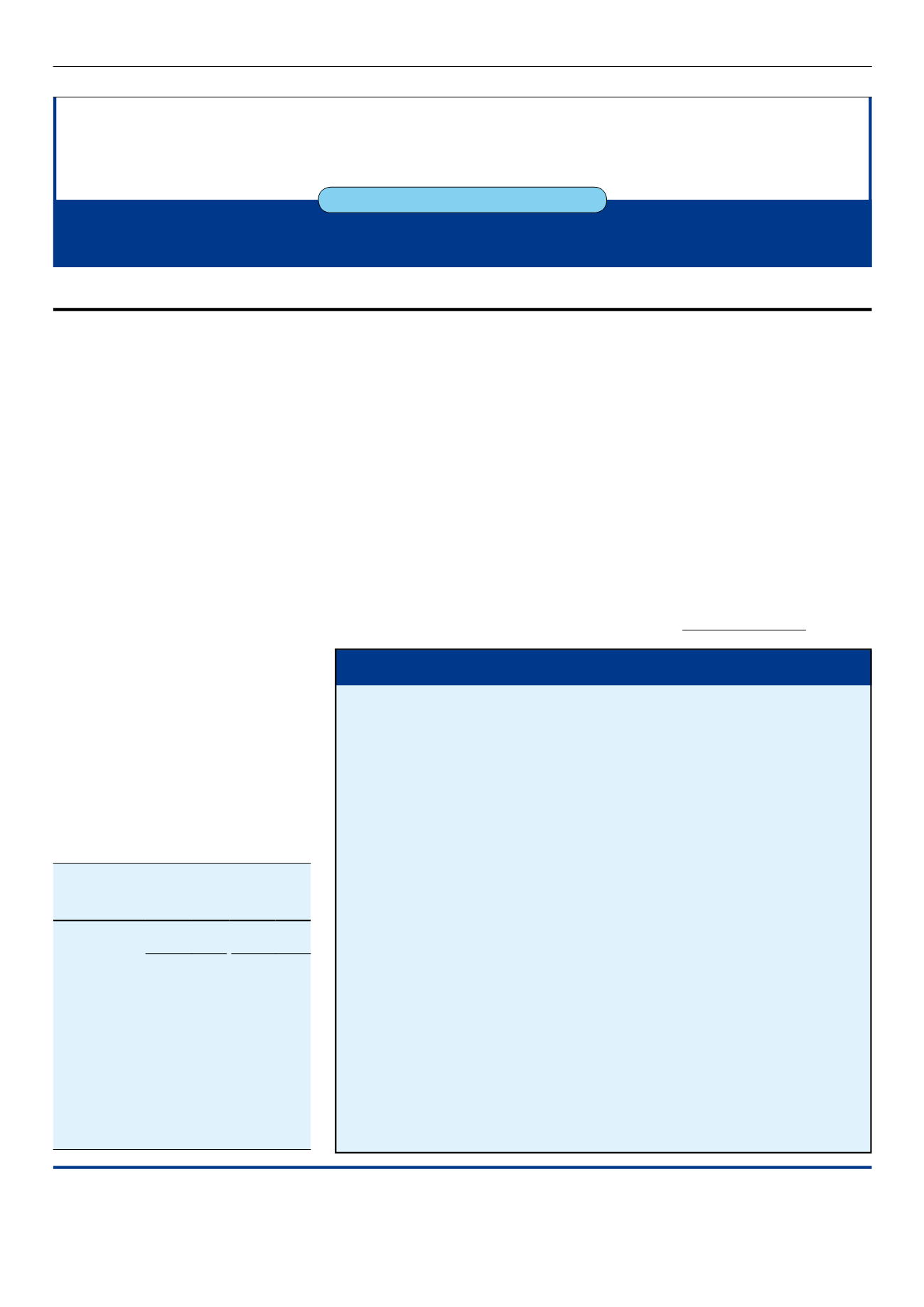
VOLUME 7 NUMBER 3 • SEPTEMBER 2010
123
SA JOURNAL OF DIABETES & VASCULAR DISEASE
ADA WATCH
2010 UPDATE FROM ORLANDO, USA
American Diabetes Association
25–29 June 2010
Contributors:
J Aalbers, Dr F Mahomed, Prof WF Mollentze
SUMMARIES
ADA WATCH
Clinical trial updates
ACCORD retinopathy study shows
intensive glycaemic control, and
combination dyslipidaemia therapy
with fenofibrate reduces retinopa-
thy progression
A study group of the ACCORD study has
shown that targeting glycaemic control at
the 6% HbA
1c
level and lipid therapy with
fenofibrate instead of placebo significantly
reduced the rate of progression of diabetic
retinopathy.
1
Intensive blood pressure con-
trol did not reduce progression.
The ACCORD study was an independ-
ent study sponsored by the National Heart,
Lung and Blood Institute and companies
did not participate in the study design or
conduct, data accrual or analysis, or manu-
script preparation, providing only the study
drugs.
The more than 10 000 ACCORD patients
with type 2 diabetes and HbA
1c
higher than
7.5% were randomly assigned to either
the intensive glycaemic-control arm or
standard control. Of these participants,
5 518 with dyslipidaemia were also ran-
domly assigned in a two-by-two factorial
design to receive simvastatin and fenofi-
brate or placebo. The remaining 4 733 par-
ticipants were randomly assigned to either
the intensive blood-pressure control (
<
120
mmHg systolic blood pressure) or standard
therapy (
<
140 mmHg).
In this ACCORD eye study, partici-
pants with retinopathy at baseline were
excluded; those included were comprehen-
sively evaluated at baseline and at year four
of the study. Progression of diabetic retin-
opathy was defined as at least three steps
on the EDTRS severity scale or development
of retinopathy requiring photocoagulation
therapy or vitrectomy.
Results of the progression to retinopathy
and moderate vision loss are summarised
in Table 1.
The early stoppage of the intensive
glycaemic-control arm due to an increased
rate of death from any cause after a mean
of 3.5 years has influenced the retinopathy
results in this arm, potentially underesti-
mating the retinopathy benefits of good
glycaemic control.
The beneficial effect of fenofibrate ther-
apy on the progression of diabetic retinopa-
thy at four years (6.3 vs 10.2% on placebo)
provides further support to the findings of
the FIELD study, which also showed visual
benefits with fenofibrate.
1.
The ACCORD stu3dy group and ACCORD Eye
study group. Effects of medical therapies on
retinopathy progression in type 2 diabetes.
N Engl
J Med
10.1056/NEJM oa1001288. Pub 29/6/2010.
TABLE OF CONTENTS
Clinical trial updates
ACCORD retinopathy study shows intensive
glycaemic control, and combination
dyslipidaemia therapy with fenofibrate
reduces retinopathy progression�������������������123
Optimising glucose control in ICU patients reduces
costs (TRIUMPH three-year results)����������������124
VADT study: further analysis of results shows
intensive glycaemic control offered some
renal protection to patients with more
advanced microvascular disease ��������������������124
VADT trial: intensive glycaemic control did
not prevent progression of calcified
atherosclerosis in patients with long-
standing type 2 diabetes��������������������������������124
Once-weekly exenatide injection improves
blood sugar control more than daily oral
sitagliptin or pioglitazone and induces
more weight loss (DURATION-2 study)����������124
Pathogenesis of type 2 diabetes
Intramyocellular lipid accumulation does not
occur in pre-diabetes, but only after
manifestation of hyperglycaemia������������������124
Insulin resistance study (IRAS) shows problems
for HBA
1c
levels as diagnostic tool �����������������124
New metabolic syndrome definition and value
of waist circumference evaluated in type 2
diabetes�����������������������������������������������������������125
Diabetes therapy
Metformin protects against antidepressant
diabetes risk? ��������������������������������������������������125
Once-daily liraglutide lowers systolic blood
pressure (SBP) in treated and untreated
hypertensive patients �������������������������������������125
Dietary omega-3 polyunsaturated fatty acid
(fish oil capsules) reduced atherosclerosis
progression in type 2 diabetes�����������������������125
Costs of continuing sulphonylureas with
insulin therapy in type 2 diabetes: more
hypoglycaemia and weight gain but less insulin
needed�������������������������������������������������������������125
Reducing complications of diabetes
Infliximab treatment improves visual acuity
in diabetic macular oedema that does not
respond to laser photocoagulation���������������126
Point-of-care testing of diabetic keto-acidosis
avoids unnecessary DKA work-ups in
hyperglycaemic patients presenting at
emergency departments ��������������������������������126
Rotating glucometer usage after achieving
glucose control in the first patient improves
HBA
1c
levels in resource-constrained settings
in Kenya�����������������������������������������������������������126
Poor glycaemic control slows wound healing���126
Encouraging and educating physicians can
result in earlier insulin prescription with
enhanced HBA
1c
control����������������������������������126
Cardiovascular outcomes trial initiated for
liraglutide��������������������������������������������������������126
Table. 1.
Progression to retinopathy and moderate
vision loss
Treatment
Progression of
retinopathy
Moderate
vision loss
n
(%)
n
(%)
Glycaemic therapy
Intensive
104/1429 (7.3) 266/1629 (16.3)
Standard
149/1427 (10.4) 273/1634 (16.7)
Dyslipidaemia
With fenofibrate 52/806 (6.5) 145/908 (16)
With placebo 80/787 (10.2) 136/893 (15.2)
Antihypertensive
Intensive
67/647 (10.4) 145/749 (19.4)
Standard
54/616 (8.8) 113/13 (15.8)


